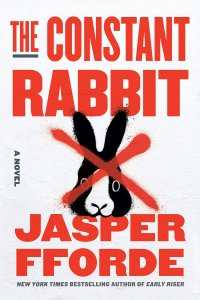Paul Di Filippo Reviews The Constant Rabbit by Jasper Fforde
 The Constant Rabbit, Jasper Fforde (Viking 978-0593296523, 320pp, $28, hardcover) September 2020.
The Constant Rabbit, Jasper Fforde (Viking 978-0593296523, 320pp, $28, hardcover) September 2020.
The trope of uplifted animals is a potent one in science fiction, especially as we advance into a future where humanity’s sheer existence more and more comes to impinge on the rest of animate creation. From Cordwainer Smith’s Underpeople to David Brin’s Uplifted dolphins to Grant Morrison’s trio of assassins, dog, cat and rabbit, in We3; from the world in Adam Robert’s Bête to the scenarios envisioned in Tim Davys’s Mollisan Town Quartet and Robert Repino’s War with No Name trilogy, we get to see how we would deal with fellow sapients who are clothed in different flesh and anatomy than us, creatures who are both familiar by their long Earth cohabitation with us, yet unfamiliar due to their increased brainpower and demands for equality. As with so much of contemporary SF, this novum traces its line of descent from Wells and his infamous island of brutal surgery through Heinlein and his “Jerry Was a Man”, with an important pit stop at Simak’s City.
Jasper Fforde’s entertaining, surprisingly thoughtful yet fleet-footed new book—a standalone novel with a climax so dramatic, irrevocable, perfect yet unpredictable that it seems impossible to extend the book to a series—is the comedic master’s foray into this thematic realm. It is, as one might expect, by turns droll and hilarious, poignant and cruel, hopeful and despairing. In other words, a true comedy in depth, a form that is not mere mindless japes and slapstick, but one which counsels us that if we don’t laugh, we must cry.
The book is narrated by an earnest, lovable, imperfect figure so well-rounded as to leap off the page and land in your lap. His name is Peter Knox. Since he is recounting from several years further down his timeline some well-known events that took place in his familiar world, there is no hand-holding introduction for the reader. One is plunged willy-nilly with a bracing shock into Peter’s reality. As with any fine SF novel, the facts emerge only gradually, in cleverly planted bits. But I will give a very brief précis so that we can discuss the book’s accomplishments. [Spoilers Ahead.]
In the year 1965 came The Event. It happened in the UK alone. A handful of rabbits—wild and lab-based and pets—were elevated magically into humanoid appearance and brainpower. These quirky anomalies were hesitantly accepted and given second-class citizen status. From these ancestors came an outpouring of descendants, until in the year 2020, some million anthropomorphic rabbits live in the UK, the majority in a handful of Warrens, but a few privileged ones living “off-colony” (Blade Runner resonance?) side-by-side with humans.
Oh, yes, a couple of other species, mainly weasels and foxes, got the same uplift. They exist in vastly smaller numbers, and with greater privileges than the Buns.
Given fifty-five years of reluctant, often hurtful coexistence, human society has evolved many institutions and rituals to deal with the Event. (Likewise, the Rabbits have created their own culture, which incorporates many behaviors from their old animal life, but also many new and surprising adaptations of human culture.) Our hero, Peter, works for RabCoT, the Rabbit Compliance Task Force. This agency basically polices the Rabbit community, often with callous brutality. It does not help that this division of RabCoT is headed by a fierce and sadistic Fox, namely Torquil Ffoxe, who has personally killed numerous Rabbits and also, as a kind of employee motivation technique, threatens to pluck out and eat Peter’s eye. Peter’s job is as a Spotter, one of those rare humans who can distinguish just by sight one Rabbit from another. This talent is very helpful when one is looking for, say, a Rabbit terrorist such as Harvey McButtercup.
But the trouble is that Peter rather likes Rabbits. Especially one Constance Rabbit, with whom he went to university, where they were almost boyfriend and girlfriend. And now, after thirty years, Constance, married to Doc, a gruff and often belligerent retired military Rabbit, has moved in next door to Peter in the vapid town of Much Hemlock. Can Peter rekindle his romance with Connie, even at the risk of getting his head blown off by one of Doc’s dueling pistols? What of Connie’s possible connections to the Rabbit Underground, whose literal patron saint is the Dalai-Lama-like Venerable Bunty, Public Enemy Number One? What of the fact that Peter’s daughter Pippa is in love with Harvey McButtercup? How can Peter placate the Mallets, a family of human chauvinists who threaten to bring in the TwoLegsGood bully boys? And lastly, how to avoid having one’s eyeball plucked out and consumed for dereliction of RabCoT duties?
The main thrust of Fforde’s story is of course the depiction of prejudice and hatred and bias between different races or species. (Rabbits call humans “Fudds,” and are not innocent of baseless contempt.) He brilliantly rings allegorical changes on all the major instances from our own timeline. One can see analogies in his book to South Africa, Ireland, the Middle East, and the USA. In fact, it quickly becomes sadly apparent that humanity’s treatment of the Rabbits reflects an almost universal historical condition. Yet Fforde never bangs the reader over the head with preachiness. And why is that? Because every character in this book is fully enlivened and treated as an individual. All the action proceeds from the basis of individual sentient desires, beliefs, emotions and ideations.
Now, creating three-dimensional humans is a trick many writers have of course mastered. But creating believable “aliens” is a much rarer gift. And here Fforde shows his genius, for he has crafted a culture for the Rabbits which is at once believable yet askew and alien from human culture. Rabbit cuisine, entertainment, love-making, child-raising, compulsive warren-digging—all elaborated on in detail. And the interspecies romance between Peter (note his Beatrix Potter-linked name) and Connie is the perfect narrative intersection and interface for the explication of these two societies. Moreover, Fforde has managed to work into his leporine theology every famous rabbit in history, from the Playboy Bunny to Bugs and Roger.
Fforde has a wonderfully rollicking time satirizing other traditional targets, such as the workplace, politicians, village life, and so forth. Note also that this book fulfills all the desiderata of an alternate history novel, which it is. His prose is always sly, inventive, and well-turned, full of absurdist metaphors and similes. He possesses a genius for staging scenes, ranging from the farcical—Connie taking a shower at Peter’s and her husband banging on the front door—to dramatic: the climactic battle at Warren One, which leads directly into that knockout ending I mentioned.
Fforde’s work bears worthy comparisons to the novels of the classic British humorist Tom Sharpe. It’s like a stimulating glass of dandelion brandy:
[Doc said,] “Have you tried dandelion brandy? Distilled from root. Makes you piss like billy-o and has the kick of a mule.”
I [had] read something that described dandelion brandy as “the diabolical three-way love child of methanol, crack cocaine and U-Boat fuel.” I’d been warned never to even go near the stuff, let alone drink it.
So I said, without so much as a pause: “Yes, I’d like that very much.”
You should say yes likewise to Fforde’s potent liquor.
 While you are here, please take a moment to support Locus with a one-time or recurring donation. We rely on reader donations to keep the magazine and site going, and would like to keep the site paywall free, but WE NEED YOUR FINANCIAL SUPPORT to continue quality coverage of the science fiction and fantasy field.
While you are here, please take a moment to support Locus with a one-time or recurring donation. We rely on reader donations to keep the magazine and site going, and would like to keep the site paywall free, but WE NEED YOUR FINANCIAL SUPPORT to continue quality coverage of the science fiction and fantasy field.
©Locus Magazine. Copyrighted material may not be republished without permission of LSFF.









Oi, spoilers! I’m a third of the way through this (and loving it by the way) and unless you’ve made a mistake in one of the dilemmas you mention, there’s a big spoiler in there that we could do without
I am no experienced critic; l am a huge Fforde fan,one who read The Eyre Affair when it was first published. The Constant Rabbit is wonderfully accessible,with a laugh on every page and characters who grab you by the throat (or kiss you). And yet all the book through, Peter Knox,our cowardly protagonist, reminds us how much we are him,prejudiced and subjugated.